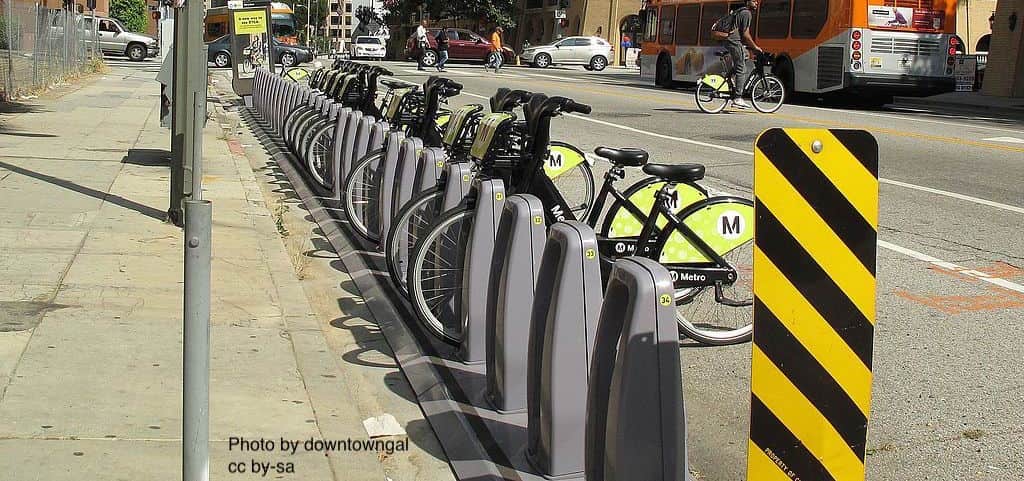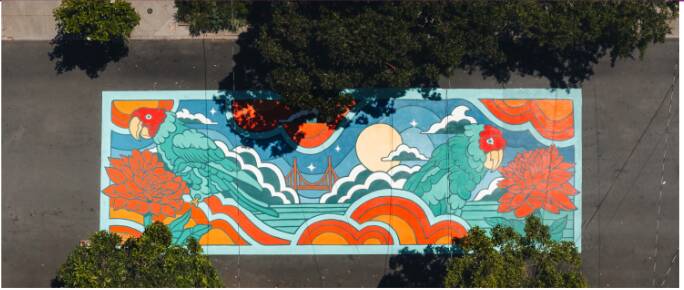Nine Uses for Daylighting Space
California’s new daylighting law prohibits parking within 20 feet of the approach to most crosswalks, creating greater visibility to reduce conflicts between people driving cars and people walking or biking across the street. The law allows communities to ticket people parked in that space, regardless of whether the curb is painted red or there is signage prohibiting parking. However, many cities are using red paint to give drivers fair warning.
Of course, a painted curb won’t stop delivery drivers, the “I’m just stopping for a minute” crowd, and other drivers from obscuring the sightlines daylighting is meant to create. The 20-foot space is about one parking space. With a little creativity, communities can activate this space, adding beauty or utility to our shared spaces while making it impossible for vehicles to occupy the daylighting zone. Here are nine ideas, ranging from the mundane to the creative, for transforming the extra space into a civic asset.
1. Bollards or posts
Bollards are boring, and a determined driver can roll over soft-hit posts. But they’re cheap, they’re easy to install and replace, and they provide an extra cue to leave the space open.
2. Bike parking corral
It’s critical to pick uses for daylighting space that don’t block the sightlines of drivers, pedestrians, or bicyclists. So, no large giraffe sculptures or walled parklets. But a bike parking corral, even when fully occupied, will allow car drivers to see people crossing. It also provides valuable bike parking that doesn’t obstruct sidewalks, which are often too narrow for these shared uses. It’s a win-win.

3. Bike or scooter share dock
Like a bike parking corral, a micromobility dock is low enough to preserve visibility. Some docks have a tall element advertising the service, which includes a screen and keypad for checking out a bike or scooter. That element should be placed at the far end of the dock, outside the daylighting zone.
4. Benches
Places to sit are crucial amenities, especially for older adults, people with mobility limitations, and, honestly, a lot of the rest of us at least some of the time. Adding benches to public spaces makes it possible for people to walk farther, knowing they’ll be able to rest when they need to. And a bench can be a place to meet friends or just watch the day roll by.
5. Public art
Artwork in daylighted space could take the form of painted asphalt, which has a proven traffic-calming effect and gives a stronger indication that it’s a no-parking zone when combined with the red curb. Larger artwork could be added, as long as it conforms to height limitations and doesn’t impede visibility.

6. Planter boxes
Taking a page from quick-build methods, planter boxes are easy to place, don’t block sightlines, and add beauty and greenery to the street.
7. Bioswales
It’s a more ambitious project, but a daylighting space could be the perfect place to remove pavement and install a bioswale. Bioswales are planted areas specifically designed to absorb stormwater runoff, relieving pressure on the sewer system and preventing flooding. As climate change brings heavier precipitation, this adaptive street feature has become more necessary. Daylighting spots near areas prone to flooding are ideal locations for stormwater mitigation.
8. Mini community gardens
Community garden space is in high demand in many neighborhoods, with long waiting lists for plots. Raised beds in daylighting spots along a street could create a linear community garden, allowing everyone to enjoy the plants growing there and gardeners to get their hands in the soil.
9. Adopt-a-space
Allowing nearby residents or businesses to adopt a daylighting space can have multiple benefits. It relieves the municipality of the expense of developing and maintaining the space. Neighbors become invested in the public space, seeing it as more than merely a lost parking spot. And plaques advertising the business or people responsible for the spot allow businesses to show they are community-minded and residents to get credit for their creativity. Of course, a program like this would require oversight, and projects would have to fall within acceptable parameters to ensure safety. Beyond that, creativity can rule. A garden store could put a demonstration plot in the space. A kitchen supplier might craft a creative outdoor sculpture from pots and pans. Schools could lay down mosaics or other artwork. The possibilities are endless.


